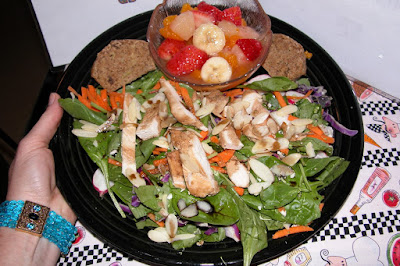Over a long weekend in January of 2005, aging serving area equipment was replaced with custom ceramic tile furnishings and black outlined sneeze guards. Thanks to a dedicated Facilities Staff, service was not interrupted.
The entire HSC Cafeteria Staff was recognized by hospital administration, each receiving a quality award. A favorite activity of the staff was a trophy award, given by peers and passed to another team member monthly. Each outgoing awardee gifted personal items-like bubble bath and flowers-to the new recipient.
Community outreach included booths at the annual Health Fair-the first focusing on sanitation, hand washing and protecting hazardous foods.
By 2004, nutrition labels accompanied all menu items at point of service. Since most items were made from scratch, and nutrition labels were not required on institutional packaging-this was no easy feat. The nutrition labels also listed ingredients.
In 2007, the cafeteria was recognized by the Whole Grains Council as a leader in Healthcare. Whole grains were purchased from a nearby farm, with whole wheat and whole corn meal grown and ground on site. Desserts and muffins were made with half whole grain flour. Whole grains, like Kamut, quinoa, oat groats and bulgur were made into entrees, sides, salads and soup. Brown rice replaced white across the menu.
Seasonal fruits and vegetables were served daily. The popular salad bar featured 24 colorful fruits and salads-all (except spinach) cleaned and cut on site.
Dried beans were cooked on site and made into salsas, soups, salads and hummus. The vegetarian bean soup sold for 25 cents less than other soups.
Because made from scratch menu items were nutrient dense, these were easy to combine as meal deals to fit into low to moderate calorie plans with less than 500 mg sodium per meal. These complemented guidelines for My Plate and the New American Plate. The few processed snack foods available were sold in smaller packages. Deli sides included a grainy item and a traditional item.
We were lucky to have a customer base that wanted to choose healthy-students, faculty and staff in health professions. Yes there were naysayers, yet there was something for everyone. It wasn't about forcing customers to choose healthy-it was about enticing them. That took a productive, committed and customer oriented food service staff to achieve.
Martha Nesser, a mentor, was a local wellness champ. She taught us to promote the good things we did and to practice good sanitation techniques. This is her recipe, a favorite of the Health Sciences Center Cafeteria and served to her family of 13:
Martha's Vegetarian Chili
(Serves 6)
2 1/2 cups cooked pinto beansPlace bulgur wheat in bowl. Heat tomatoes to boiling and add to the bulgur wheat. Stir and let stand approximately 15 minutes.
1 cup bulgur wheat
14 ounces diced tomatoes, canned in juice
Heat remaining ingredients in kettle and simmer.
1/3 cup onion, diced
2 cloves garlic, minced
1 cup green pepper, diced
1/4 cup celery, diced
1/4 cup carrots, peeled and diced
6 ounces tomato paste
2 1/4 cups water
2 teaspoon basil
2 teaspooon chili powder
1 teaspoon cumin
1/4 teaspoon cinnamon.
Just 15 minutes before serving, add bulgur/tomato mixture and beans. Keep hot for service.








No comments:
Post a Comment